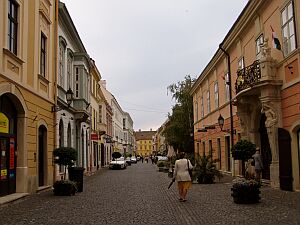Official Name
Győr. Note that the name is pronounced [ Djeir ] (at least it's close to the real pronunciation, for the proper pronunciation of 'gy' and 'ő' see → Hungarian language). Since some computers may not display the special character 'ő' correctly, it is often written Gyõr, Györ or simply Gyor. Once there was a Roman settlement nearby, which was called Arrabona. And of course there's a German name, too: Raab (because of the river with the same name).
Location

| ||
| Gyor |
Győr is a large town in Western Transdanubia and only a few kilometres south of the border to →Slovakia. To Bratislava in the north-west it's only around 70 km, to →Budapest in the east about 100 km. Near Győr, the two rivers Rábca and Rába (Raab) flow into the Mosoni-Danube, which again is an arm of the main river. The main arm of the Danube river flows further to the north.
Population
Around 130,000.
Orientation
Győr is the third largest industrial centre of Hungary, which is hard to believe for visitors. The old town centre stretches along the river Rába - a tributary of the Danube - in the north and in the west. The Bishop's Castle towers above the river on the top of a spur. Southeast of the castle, the rather small old town stretches all the way to the railway tracks in the south. The castle and the train station are connected by a long pedestrian zone called Baross Gábor utca. The tourist information can be found in that street not far from the train station. Right behind the train station there's the bus terminal - accessible from the train station by a dark tunnel. As in many other Hungarian cities, the main square is called Széchenyi tér. Many lanes in the area between main square and Bishop's Palace are particularly beautiful, with most of them being closed to traffic. The homogeneity of the centre is very nice - there are almost no newer buildings at all.

| ||
| The old town centre of Győr |
History
Almost two thousand years ago, the small settlement Arrabona marked the northern border of the Roman province Transdanubia. In the 11th century, the first Hungarian king, Stephen I, made the town the residence of the bishop - remainings from that time can still be seen inside the Bishop's castle.
In the middle of the 16th century, the town was transformed into a fortress to protect it from the gradually advancing Ottoman empire. But the Ottomans never reached Győr - and so, in contradiction to Hungarian towns like →Pécs - there are no Turkish remainings in the town. Today, Győr is an important industrial town.
Getting there / transportation
Győr lies between Vienna and Budapest, which can be said about railway connections as well. Several daily local as well as express trains running between →Budapest and Vienna stop in Győr (most trains depart from Déli und Keleti pu., in Vienna they mostly arrive at the Südbahnhof = South terminal). Even the international express train from and to →Belgrade stop in Győr. The ride to Budapest takes around 1½ hrs, the local train to Vienna needs two hours. The fare to Vienna is 4,000 Ft. There are only two direct trains a day to Bratislava. Some local trains run southwards as far as Veszprém near Lake Balaton.
Of course there are also many bus connections. Buses are the better option when heading for destinations around Lake Balaton. The bus station is right behind the train station.
The best thing to do is just to walk around the old town centre. Kitty-corner from the train station there's the rectangular Városháza Square with the large town hall.

| ||
| The neo-baroque town hall of Győr |
The neo-baroque town hall facing the square is quite big and was completed in the year 1898. It is lit up at night, so it's worth to have a look at it in the evening as well.

| ||
| The central square Széchenyi tér |
The historic centre of town is marked by Széchenyi tér with the Column of the Holy Virgin standing in the middle and baroque St. Ignatius Church facing the square. The latter was built in 1641 and is one of the most beautiful churches in town. Most of the buildings were erected during the 17th and 18th century and are perfectly preserved.
Unfortunately, Bishop's Palace was closed when we visited the town - and so I can't write about it. It seems to be worth a visit...
Around 20 km south of Győr you will find the huge Pannonhalma Monastery on the top of a hill. The construction of the monastery was started around the year 1000. It's possible to get there from Győr by buses and trains.
It looks like there are many private rooms, most of them located in the city centre. But there's also a large hotel right in front of the train station. Get out of the train station direction old town and you will stand in front of Hotel Szárnyaskerék. The hotel is run by the national railway company and a bit drab. However, the rooms are very clean. A double room (bathroom is on the floor) will set you back € 22. Here's the address: Révai Miklós utca 5, Tel.: 314 629.
- www.visitors.hu/05_02_en.html Extensive website about Győr, Pannonhalma and the entire region.
- www.gyor.hu The official website of the town. Partially under construction.
Do you have or do you know a good website about Győr? Don't hesitate, let me know! After checking it, I would love to add it to the link list. You can submit a link by using the →contact form. Note that commercial websites will be treated differently.
©2024 Europe-East.com

 Albania
Albania Hungary
Hungary